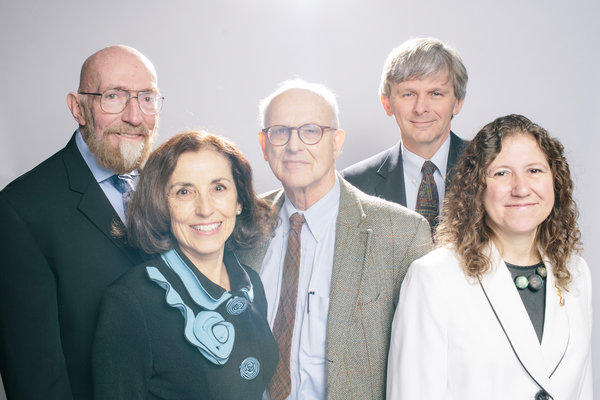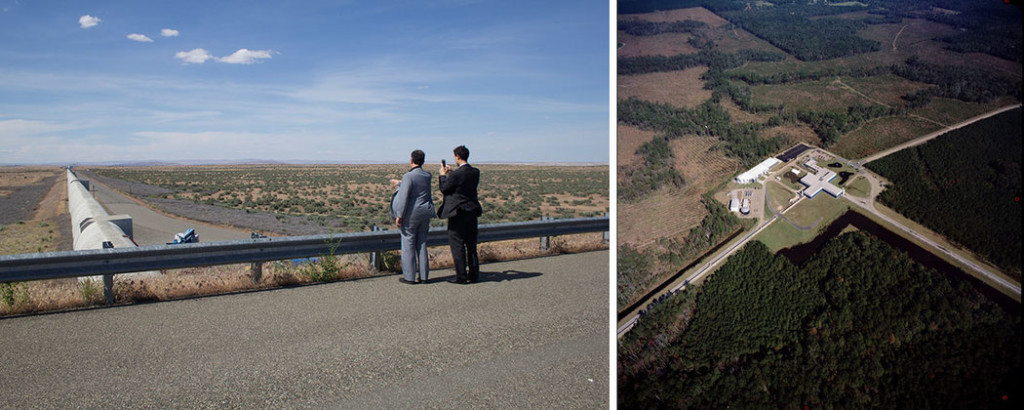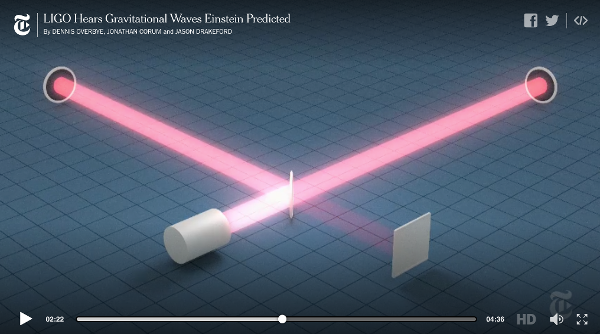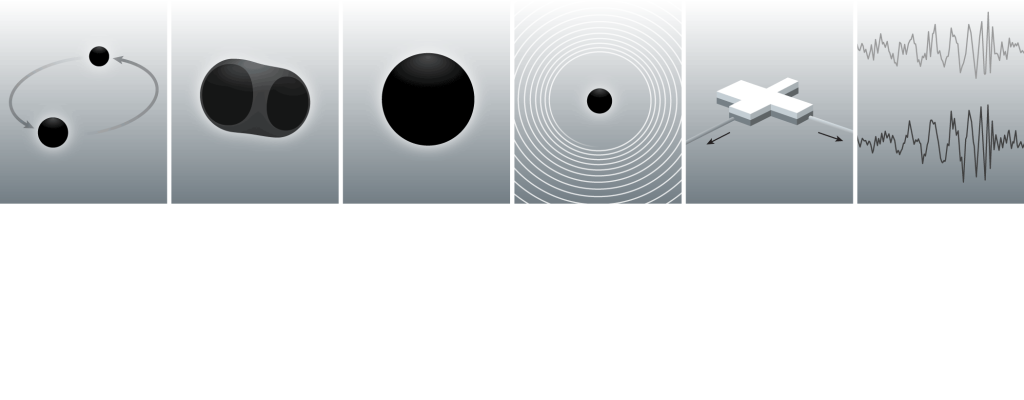Gravitational Waves Detected, Confirming Einstein’s Theory
SCIENCE, 22 Feb 2016
Dennis Overbye, Jonathan Corum and Jason Drakeford – International New York Times
11 Feb 2016 – A team of scientists announced on Thursday [11 Feb] that they had heard and recorded the sound of two black holes colliding a billion light-years away, a fleeting chirp that fulfilled the last prediction of Einstein’s general theory of relativity.
That faint rising tone, physicists say, is the first direct evidence of gravitational waves, the ripples in the fabric of space-time that Einstein predicted a century ago. (Listen to it here.) It completes his vision of a universe in which space and time are interwoven and dynamic, able to stretch, shrink and jiggle. And it is a ringing confirmation of the nature of black holes, the bottomless gravitational pits from which not even light can escape, which were the most foreboding (and unwelcome) part of his theory.
More generally, it means that a century of innovation, testing, questioning and plain hard work after Einstein imagined it on paper, scientists have finally tapped into the deepest register of physical reality, where the weirdest and wildest implications of Einstein’s universe become manifest.
Conveyed by these gravitational waves, power 50 times greater than the output of all the stars in the universe combined vibrated a pair of L-shaped antennas in Washington State and Louisiana known as LIGO on Sept. 14.
If replicated by future experiments, that simple chirp, which rose to the note of middle C before abruptly stopping, seems destined to take its place among the great sound bites of science, ranking with Alexander Graham Bell’s “Mr. Watson — come here” and Sputnik’s first beeps from orbit.
These chirps are gravitational waves converted to audible sounds. The faint thump matches the gravitational waves’ frequencies. The louder chirp is a higher frequency better suited to human ears. LIGO
“We are all over the moon and back,” said Gabriela González of Louisiana State University, a spokeswoman for the LIGO Scientific Collaboration, short for Laser Interferometer Gravitational-Wave Observatory. “Einstein would be very happy, I think.”
Members of the LIGO group, a worldwide team of scientists, along with scientists from a European team known as the Virgo Collaboration, published a report in Physical Review Letters on Thursday with more than 1,000 authors.
“I think this will be one of the major breakthroughs in physics for a long time,” said Szabolcs Marka, a Columbia University professor who is one of the LIGO scientists.
“Everything else in astronomy is like the eye,” he said, referring to the panoply of telescopes that have given stargazers access to more and more of the electromagnetic spectrum and the ability to peer deeper and deeper into space and time. “Finally, astronomy grew ears. We never had ears before.”
Long-Awaited Triumph
The discovery is a great triumph for three physicists — Kip Thorne of the California Institute of Technology, Rainer Weiss of the Massachusetts Institute of Technology and Ronald Drever, formerly of Caltech and now retired in Scotland — who bet their careers on the dream of measuring the most ineffable of Einstein’s notions.

Important players in the LIGO project, from left to right: Kip Thorne of the California Institute of Technology, France A. Córdova of the National Science Foundation, Rainer Weiss of the Massachusetts Institute of Technology, David Reitze of Caltech and Gabriela González of Louisiana State University. Credit Lexey Swall for The New York Times
“Until now, we scientists have only seen warped space-time when it’s calm,” Dr. Thorne said in an email. “It’s as though we had only seen the ocean’s surface on a calm day but had never seen it roiled in a storm, with crashing waves.”
The black holes that LIGO observed created a storm “in which the flow of time speeded, then slowed, then speeded,” he said. “A storm with space bending this way, then that.”
The chirp is also sweet vindication for the National Science Foundation, which spent about $1.1 billion over more than 40 years to build a new hotline to nature, facing down criticism that sources of gravitational waves were not plentiful or loud enough to justify the cost.
“It’s been decades, through a lot of different technological innovations,” France Córdova, the foundation’s director, said in an interview, recalling how, in the early years, the foundation’s advisory board had “really scratched their heads on this one.”
Word of LIGO’s success was met by hosannas in the scientific community, albeit with the requisite admonishments of the need for confirmation or replication.
“I was freaking out,” said Janna Levin, a theorist at Barnard College at Columbia who was not part of LIGO but was granted an early look at the results for her warts-and-all book about the project, “Black Hole Blues,” to be published this spring.
Robert Garisto, the editor of Physical Review Letters, said he had gotten goose bumps while reading the LIGO paper.
Elusive Disturbances
When Einstein announced his theory in 1915, he rewrote the rules for space and time that had prevailed for more than 200 years, since the time of Newton, stipulating a static and fixed framework for the universe. Instead, Einstein said, matter and energy distort the geometry of the universe in the way a heavy sleeper causes a mattress to sag, producing the effect we call gravity.

A pair of L-shaped antennas, known as LIGO, in Hanford, Wash., left, and Livingston, La., detected the gravitational waves on Sept. 14. Credit Caltech-M.I.T.-LIGO Lab
A disturbance in the cosmos could cause space-time to stretch, collapse and even jiggle, like a mattress shaking when that sleeper rolls over, producing ripples of gravity: gravitational waves.
Einstein was not quite sure about these waves. In 1916, he told Karl Schwarzschild, the discoverer of black holes, that gravitational waves did not exist, then said they did. In 1936, he and his assistant Nathan Rosen set out to publish a paper debunking the idea before doing the same flip-flop again.
According to the equations physicists have settled on, gravitational waves would compress space in one direction and stretch it in another as they traveled outward.
In 1969, Joseph Weber, a physicist at the University of Maryland, claimed to have detected gravitational waves using a six-foot-long aluminum cylinder as an antenna. Waves of the right frequency would make the cylinder ring like a tuning fork, he said.
Others could not duplicate his result, but few doubted that gravitational waves were real. Dr. Weber’s experiment inspired a generation of scientists to look harder for Einsteinian marks on the universe.
In 1978, the radio astronomers Joseph H. Taylor Jr. and Russell A. Hulse, then at the University of Massachusetts Amherst, discovered a pair of neutron stars, superdense remnants of dead stars, orbiting each other. One of them was a pulsar, emitting a periodic beam of electromagnetic radiation. By timing its pulses, the astronomers determined that the stars were losing energy and falling closer together at precisely the rate that would be expected if they were radiating gravitational waves.
Dr. Hulse and Dr. Taylor won the Nobel Prize in Physics in 1993.
Another group of astronomers who go by the name Bicep made headlines in 2014 when they claimed to have detected gravitational waves from the beginning of the Big Bang, using a telescope at the South Pole. They later acknowledged that their observations had probably been contaminated by interstellar stardust.
A Quixotic Project
Dr. Thorne of Caltech and Dr. Weiss of M.I.T. first met in 1975, Dr. Weiss said, when they had to share a hotel room during a meeting in Washington. Dr. Thorne was already a renowned black-hole theorist, but he was looking for new experimental territory to conquer. They stayed up all night talking about how to test general relativity and debating how best to search for gravitational waves.
Dr. Thorne then recruited Dr. Drever, a gifted experimentalist from the University of Glasgow, to start a gravitational wave program at Caltech. Dr. Drever wanted to use light — laser beams bouncing between precisely positioned mirrors — to detect the squeeze and stretch of a passing wave.
Dr. Weiss tried to mount a similar effort at M.I.T., also using the laser approach, but at the time, black holes were not in fashion there. (Things are better now, he said.)
The technological odds were against both efforts. The researchers calculated that a typical gravitational wave from out in space would change the distance between a pair of mirrors by an almost imperceptible amount: one part in a billion trillion. Dr. Weiss recalled that when he explained the experiment to his potential funders at the National Science Foundation, “everybody thought we were out of our minds.”
In 1984, to the annoyance of Dr. Drever and the relief of Dr. Weiss, the National Science Foundation ordered the two teams to merge. Dr. Thorne found himself in the dual roles of evangelist for the field of gravitational waves and broker for experimental disagreements.
Progress was slow until the three physicists were replaced in 1987 by a single director as part of the price of going forward.
The first version of the experiment, known as Initial LIGO, started in 2000 and ran for 10 years, mostly to show that it could work on the scale needed. There are two detectors: one in Hanford, Wash., the other in Livingston, La. Hunters once shot up the outside of one of the antenna arms in Louisiana, and a truck crashed into one of the arms in Hanford. In neither case was the experiment damaged.
Over the last five years, the entire system was rebuilt to increase its sensitivity to the point where the team could realistically expect to hear something.
LIGO’s antennas are L-shaped, with perpendicular arms 2.5 miles long. Inside each arm, cocooned in layers of steel and concrete, runs the world’s largest bottle of nothing, a vacuum chamber a couple of feet wide containing 2.5 million gallons of empty space. At the end of each arm are mirrors hanging by glass threads, isolated from the bumps and shrieks of the environment better than any Rolls-Royce ever conceived.
Thus coddled, the lasers in the present incarnation, known as Advanced LIGO, can detect changes in the length of one of those arms as small as one ten-thousandth the diameter of a proton — a subatomic particle too small to be seen by even the most powerful microscopes — as a gravitational wave sweeps through.
Even with such extreme sensitivity, only the most massive and violent events out there would be loud enough to make the detectors ring. LIGO was designed to catch collisions of neutron stars, which can produce the violent flashes known as gamma ray bursts.
As they got closer together, these neutron stars would swing around faster and faster, hundreds of times a second, vibrating space-time geometry with a rising tone that would be audible in LIGO’s vacuum-tube “sweet spot.”
Black holes, the even-more-extreme remains of dead stars, could be expected to do the same, but nobody knew if they existed in pairs or how often they might collide. If they did, however, the waves from the collision would be far louder and lower pitched than those from neutron stars.
Dr. Thorne and others long thought these would be the first waves to be heard by LIGO. But even he did not expect it would happen so quickly.
‘It Was Waving Hello’
On Sept. 14, the system had barely finished being calibrated and was in what is called an engineering run at 4 a.m. when a loud signal came through at the Livingston site. “Data was streaming, and then ‘bam,’ ” recalled David Reitze, a Caltech professor who is the director of the LIGO Laboratory, the group that built and runs the detectors.
Seven milliseconds later, the signal hit the Hanford site. LIGO scientists later determined that the likelihood of such signals landing simultaneously by pure chance was vanishingly small. Nobody was awake in the United States, but computers tagged the event, and European colleagues noticed.
Dr. Reitze was on a plane to Louisiana the next day. Dr. Weiss, on vacation in Maine, found out when he checked in by computer that morning. “It was waving hello,” he said. “It was amazing. The signal was so big, I didn’t believe it.”
The frequency of the chirp was too low for neutron stars, the physicists knew. Detailed analysis of its form told a tale of Brobdingnagian activities in a far corner of the universe: the last waltz of a pair of black holes shockingly larger than astrophysicists had been expecting.
One of them was 36 times as massive as the sun, the other 29. As they approached the end, at half the speed of light, they were circling each other 250 times a second.
And then the ringing stopped as the two holes coalesced into a single black hole, a trapdoor in space with the equivalent mass of 62 suns. All in a fifth of a second, Earth time.
Dr. Weiss said you could reproduce the chirp by running your fingernails across the keys of a piano from the low end to middle C.
Lost in the transformation was three solar masses’ worth of energy, vaporized into gravitational waves in an unseen and barely felt apocalypse. As visible light, that energy would be equivalent to the brightness of a billion trillion suns.
And yet it moved the LIGO mirrors only four one-thousandths of the diameter of a proton.
The signal conformed precisely to the predictions of general relativity for black holes as calculated in computer simulations, Dr. Reitze said.
Shortly after the September event, LIGO recorded another, weaker signal that was probably also from black holes, the team said. According to Dr. Weiss, there were at least four detections during the first LIGO observing run, which ended in January. The second run will begin this summer. In the fall, another detector, Advanced Virgo, operated by the European Gravitational Observatory in Italy, will start up. There are hopes for more in the future, in India and Japan.
Looking Forward
Astronomers now know that pairs of black holes do exist in the universe, and they are rushing to explain how they got so big. According to Vicky Kalogera of Northwestern University, there are two contenders right now: Earlier in the universe, stars lacking elements heavier than helium could have grown to galumphing sizes and then collapsed straight into black holes without the fireworks of a supernova explosion, the method by which other stars say goodbye. Or it could be that in the dense gatherings of stars known as globular clusters, black holes sink to the center and merge.
Michael S. Turner, a cosmologist at the University of Chicago, noted that astronomers had once referred to the search for gravitational waves as an experiment, not an observatory. “LIGO has earned its ‘O,’ ” he said. “That is, it will be an observatory, getting tens of events per year.”
**********************************************************
Hearing a Gravitational Wave
Predicted by Einstein’s general theory of relativity 100 years ago, gravitational waves have been directly detected for the first time. LIGO, the Laser Interferometer Gravitational-Wave Observatory, heard black holes colliding.
1- TWO BLACK HOLES – About 1.2 billion years ago in a distant galaxy, a pair of black holes circled each other. The larger black hole was 36 times the mass of our sun, and the smaller one 29 times.
2- COLLISION – The intense gravity accelerated the black holes to half the speed of light, pulling them closer and carving distortions in space and time. In a fraction of a second, the pair collided and merged into an irregular shape.
3- RING DOWN – The unstable blob smoothed into a sphere, a process called ring down. Three solar masses’ worth of energy were vaporized in a storm of gravitational waves, distorting space and time and leaving a new black hole 62 times the mass of the sun.
4- GRAVITATIONAL WAVES – The invisible waves rippled outward at the speed of light. But waves fade with distance, and when they finally reached Earth, the distortions were too small to be measured above the heat, noise and other vibrations of our planet.
5- DETECTION – LIGO is a pair of L-shaped observatories 1,900 miles apart. Ultra-pure mirrors at the ends of each arm are isolated from vibrations. Passing gravitational waves push and pull the arms, changing the length of tunnels by less than the width of a proton.
6- A CHIRP – On Sept. 14, LIGO’s detectors measured their first vibrations from a gravitational wave. Translated to sound, it was a short chirp, the billion-year-old echo of the collision of those two black holes.
**********************************************************
Dr. Turner added, “The loudest things in the gravity-wave sky are the most exotic things in the universe: black holes, neutron stars and the early universe.”
The future for the dark side looks bright.
“There just have to be big, momentous surprises, which there always have been when a new window is opened,” said Dr. Thorne, who is now retired from LIGO.
Dr. Drever, who has dementia and lives in a nursing home near Edinburgh, is not able to enjoy the victory lap. “Ron’s creative genius was crucial to LIGO’s future success and was the reason we brought him to Caltech,” Dr. Thorne wrote in an email.
Dr. Weiss, who is retired with emeritus status at M.I.T., said his life now was more like that of a graduate student — that is to say, tinkering and making things work. This tendency was almost the undoing of the LIGO discovery. Only three days before the black hole chirp came in, Dr. Weiss was at the Livingston site, he recalled, and was horrified to find that the antenna readings were plagued by radio interference.
That needs to be fixed, he told his colleagues, imploring them to delay the engineering run. But they demurred, saying that everything was ready, that it was too late to stop the program. Lucky for them.
“We would have missed that big event,” Dr. Weiss said.
**********************
Click to Watch the Amazing Video Here – About a hundred years ago, Einstein predicted the existence of gravitational waves, but until now, they were undetectable.
An Earthling’s Guide to Black Holes – Welcome to the place of no return — a region in space where the gravitational pull is so strong that not even light can escape it. This is a black hole.
What Is General Relativity? – Einstein presented his general theory of relativity 100 years ago this month.
_________________________________________
A version of this article appears in print on February 12, 2016, on page A1 of the New York edition with the headline: With Faint Chirp, Scientists Prove Einstein Correct.
DISCLAIMER: The statements, views and opinions expressed in pieces republished here are solely those of the authors and do not necessarily represent those of TMS. In accordance with title 17 U.S.C. section 107, this material is distributed without profit to those who have expressed a prior interest in receiving the included information for research and educational purposes. TMS has no affiliation whatsoever with the originator of this article nor is TMS endorsed or sponsored by the originator. “GO TO ORIGINAL” links are provided as a convenience to our readers and allow for verification of authenticity. However, as originating pages are often updated by their originating host sites, the versions posted may not match the versions our readers view when clicking the “GO TO ORIGINAL” links. This site contains copyrighted material the use of which has not always been specifically authorized by the copyright owner. We are making such material available in our efforts to advance understanding of environmental, political, human rights, economic, democracy, scientific, and social justice issues, etc. We believe this constitutes a ‘fair use’ of any such copyrighted material as provided for in section 107 of the US Copyright Law. In accordance with Title 17 U.S.C. Section 107, the material on this site is distributed without profit to those who have expressed a prior interest in receiving the included information for research and educational purposes. For more information go to: http://www.law.cornell.edu/uscode/17/107.shtml. If you wish to use copyrighted material from this site for purposes of your own that go beyond ‘fair use’, you must obtain permission from the copyright owner.


Einstein’s Unification Theory Akin to Phonon & Vedas
ABSTRACT
The recent discovery of Gravitational wave is a clear signal from the universe that Einstein got it right and his gravitational waves were real. The Gravitational waves are akin to sound waves that travelled through space at the speed more than the light. The photon–phonon interaction plays an important role in modern physics and device applications, photons can be scattered by phonons in a crystal. It has opened a new window to discuss photon-phonon interaction as two distinct opposite forces interacting with each other at molecular level Li, E. et al. Photonic Aharonov–Bohm effect in photon–phonon interactions. Nat. Commun. 5:3225 doi: 10.1038/ncomms4225 (2014)
The vibrations of sound and electromagnetic rays travel parallel with each other in straight way. The voice is identity of life; the DNA mental code grasps it first in the womb and pronounced it with birth of infant to cherish the life, just like current of a river in the ocean of life.
The phonic presser compress the plasma membrane, the configuration of electrons with half spin change the wavelength on opposite side and reached to brain with electromagnetic impulses for action. It is phonic presser compression electromagnetic force, which connects the body with single unified force.
It has been searched earlier also at Grand Canyon and Egypt with its text in Vedic metaphor symbols to explain universe and life on the earth. It is interesting and amazing to know that Photon and Phonon two distinct equal and opposite forces of nature. They interact with each other in various ways and held up the creation and life, under space time fabric.
The life is present on the earth, due to Gravitational sound waves and geomagnetism on earth. It requires radical rethinking on cosmology to understand universe and life.
Key words- Phonic presser, Phonon, cosmology, unification theory
Dr.Chandra P. Trivedi
Einstein’s Unification Theory Akin to Phonon
ABSTRACT
The recent discovery of Gravitational wave is a clear signal from the universe that Einstein got it right and his gravitational waves were real. The Gravitational waves are akin to sound waves that travelled through space at the speed more than the light. The photon-phonon interaction plays an important role in modern physics and device applications, photons can be scattered by phonons in a crystal. It has opened a new window to discuss photon-phonon interaction as two distinct opposite forces interacting with each other at molecular level Li, E. et al.
The Photon and Phonon are two distinct opposite complimentary forces of nature. They held up the creation and life, under space time fabric.
The Phonon is earliest with pre-cosmic dawn; it has activated the dark matter with echo in ripper with blast and light.
The voice is identity of life; the DNA mental code grasps it first in the womb and pronounced it with birth of infant to cherish the life, The DNA is instrument of life. The cellular body beholds the thought mentality adorned to body.
The phonic presser compress the plasma membrane, the configuration of electrons with half spin change the wavelength on opposite side and reached to brain with electromagnetic impulses for action. It is phonic presser compression electromagnetic force, which connects the body with single unified force Phonon.
Key words- s cosmology W Phonic presser, Phonon, Dw unification theory